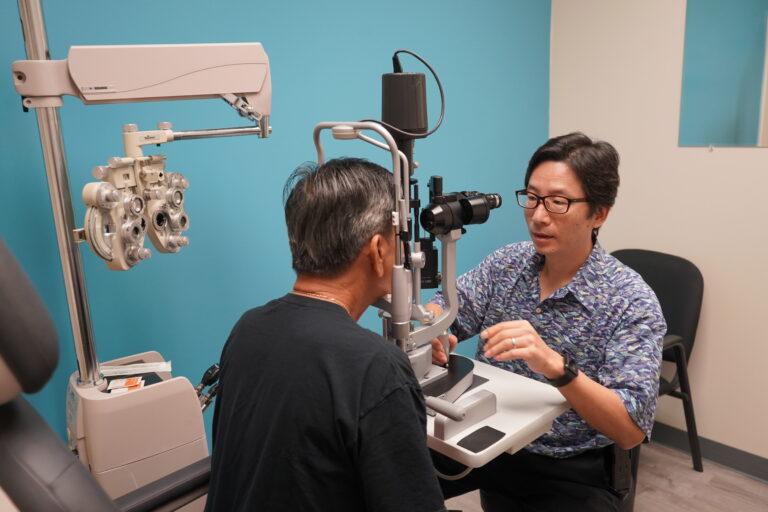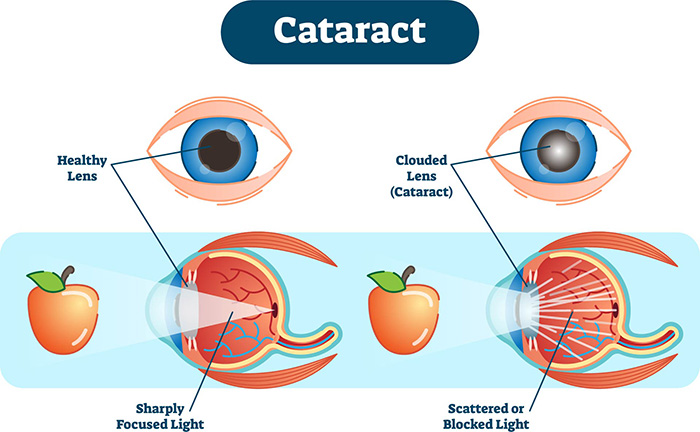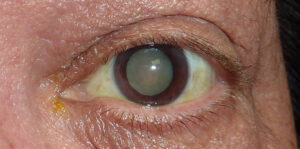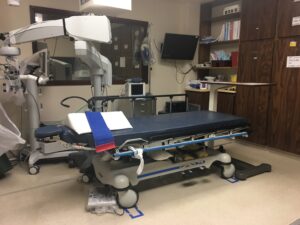
Advanced Cataract Care with a Personal Touch
Thanks to modern cataract surgery, it is never necessary to wait until a cataract is “ripe.” In fact, it is best to remove the cataract once it begins to cause trouble with your eyesight. Here at Hawaiian Eye Center, we offer a range of personalized cataract treatments and surgery to restore clear vision.
We want all of our patients to be able to make smart decisions when it comes to picking the right cataract treatment and the best cataract surgeon for your needs. If you have a question about cataracts, you may give us a call at one of our locations or refer to our page on eye conditions for more in depth information on cataracts.
What to expect with our Cataract Surgery
 We understand that eye procedures can be intimidating, and that is why at Hawaiian Eye Center, we pride ourselves on offering the latest techniques and technology for cataract care to make sure our patients are best cared for.
We understand that eye procedures can be intimidating, and that is why at Hawaiian Eye Center, we pride ourselves on offering the latest techniques and technology for cataract care to make sure our patients are best cared for.
In our modern high-tech Surgicenter, our Anesthesiologist will give you medications to help relax you and to provide comfort throughout the procedure. The cataract is removed using a procedure known as phacoemulsification in which high frequency sound waves (ultrasound) are used to break up and remove the cloudy cataract. This technique allows for safe removal of the cataract utilizing a tiny incision less than 1/8″ wide. After the ultrasound breaks up the cataract, it is vacuumed out through the tiny incision in the eye.
In addition, our Surgicenter offers Laser Assisted Cataract Surgery (LACS). LACS is the most advanced type of cataract surgery available. A computer guided laser is used to make the incisions and cuts during the initial steps of the surgery, providing a more precise and accurate technique over the manual procedure.
Once the procedure is finished, the incision is so small that it seals by itself, often without the need for stitches. Thus, the term “no-stitch” cataract surgery.
People are generally awake but relaxed during surgery. Many report seeing an enjoyable display of colored lights during surgery. Thanks to anesthesia and modern surgical techniques, the procedure is short and without any discomfort.
What to expect with Cataract Lens Implants
 Once the cataract has been removed, a tiny lens implant is placed into the eye to restore the focusing power lost with the removal of the cataract which is the natural lens. The implants can’t be felt, usually can’t be seen, and doesn’t need to be changed or cleaned.
Once the cataract has been removed, a tiny lens implant is placed into the eye to restore the focusing power lost with the removal of the cataract which is the natural lens. The implants can’t be felt, usually can’t be seen, and doesn’t need to be changed or cleaned.
There are several lens implant options. The standard lens implant is designed to provide good focus for distance vision. Most people who receive the standard lens implant do need glasses after cataract removal, either for reading or for clearest vision for both distance and reading.
Along with our standard lens, we also offer advanced lens implants which can help reduce dependence on glasses after surgery. New advanced technology implants have recently been developed which can help provide good distance and reading vision after surgery. Other implants can reduce astigmatism. These implants can require special measurements and procedures to provide best possible vision without glasses. They are no better for your eye than the standard implant but can provide a greater range of focus without glasses. These special implants have some unique characteristics and are not covered by insurance. Be sure to ask your doctor about the advanced lens implants if you are interested in reducing your dependence on glasses after surgery.
What to keep in mind when getting Cataract surgery
 You may find that the vision is blurry at first or that you feel off balance from the changes in your eye. You may also temporarily see some spots in the vision, an arc or shadow in the peripheral vision, or other changes in your vision. This is normal and improves with time. You will be instructed to call immediately if you have any problem at all after surgery. There is always a doctor available to answer your call.
You may find that the vision is blurry at first or that you feel off balance from the changes in your eye. You may also temporarily see some spots in the vision, an arc or shadow in the peripheral vision, or other changes in your vision. This is normal and improves with time. You will be instructed to call immediately if you have any problem at all after surgery. There is always a doctor available to answer your call.
Please note that after the cataract is removed, a small membrane called the lens capsule is left in the eye to support the placement of the new lens implant. Months to years following the cataract procedure, this capsule can become wrinkled or cloudy. Often this blurs the vision, making it seem the vision is hazy or cloudy. Sometimes, it feels as if the cataract has returned.
If the cloudy capsule is affecting the vision, it’s easy to treat. A quick painless procedure can be done with the laser to open the cloudy capsule and improve the eye’s focus. The laser light is really just a strong focused pulse of light which opens the cloudy area. The procedure takes only a few minutes, is completely painless, and usually permanently sharpens your focus.
Please also be advised that measurements of the eye are not always exact, which may affect lens implants. Sometimes, our calculations for the lens do not give us the exact lens power needed for the vision you would like without glasses, even if you choose an advanced implant designed to reduce the need for glasses. Sometimes astigmatism can keep you from having good vision without glasses after cataract removal. Many people may still need glasses after cataract removal. Many people do still need glasses after cataract surgery for the clearest vision. Rarely, if you are uncomfortable with your focus after surgery the lens can be changed, or another procedure performed to improve the focus.
It is important to note that it is more difficult to find the correct implant power if you’ve had previous refractive surgery such as LASIK, PRK or RK. If you have had any of these procedures, please inform your doctor. In addition, contact lenses need to be out of the eyes for a period of time before the surgery (one week for soft lenses, 3-4 weeks for glass permeable or hard lenses). Please make sure to inform our doctors or staff if you wear contact lenses.


